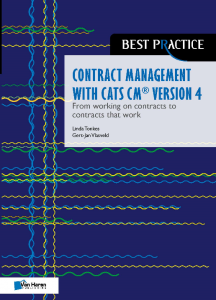CATS CM® methodology – Pillar 4 Part 1: Six steps in the contract management process
Author: Linda Tonkes
In this twelfth blog from the series ‘Contract Management with CATS CM® in a nutshell’, I will focus on a part of the fourth pillar of the CATS CM® methodology. The fourth pillar consists of the contract management process subdivided into 6 steps and the structuring of these steps through contract management scenarios. This blog gives more details about the contract management process.
The six steps of the contract management process
The steps in the methodology are based on the Deming cycle. Because contract management has specific start and end points, two additional steps were added to this method: the Initiate step at the start of the process and the Conclude step upon its conclusion. Between the Initiate and the Conclude steps, the contract manager will carry out the steps: Plan, Do, Check, and Act/Adjust several times.

Initiate step
The first step of the contract management process is called the Initiate step. With this step, the contract management process based on CATS CM® starts. It paves the way for the further execution of contract management. The contract manager prepares for managing the execution phase of the contract and consults with the contract owner and the realization and verification manager. A properly concluded Initiate step ensures that not only the contract manager but also the entire contract team is well-prepared. A sound preparation also ensures that the contract manager, when necessary, is supported by colleagues (with time or expertise) as clear agreements have been made as to how the contract manager’s performance will be assessed and whether and when the job has been successful.
Plan-Do-Check-Act/Adjust-Cycle
The Plan step is the first step in the repetitive PDCA cycle. The contract manager first determines what must be achieved during the execution of this cycle. For example: what opportunities can be identified to increase the certainty that the contract objectives will be achieved? With the Do step, the contract manager takes the actions (or has others do so) that were identified during the Plan step. With the Check step, the contract manager checks the results of the actions taken during the Do step and evaluates whether or not the results match with the intended goal. During the Act/Adjust step, the contract manager identifies possible adjustments based on the outcome of the Check step, and implements them. These adjustments can relate to three different aspects. Firstly, to the contract itself, such as adjustments or additions to the contract, or extending a contract. Secondly, to the contract management approach as established in the CM plan and to the actions required for the different CM Essentials, such as risk management activities. Thirdly, they can relate to the knowledge, skills, and competencies of the contract manager. Attentive readers will recognize the contract management success factors from my third blog in this series.
Conclude step
The PDCA cycle continues as long as performance is delivered. However, the preparations for the Conclude step, the final step in the process, may already be initiated. During this step, the contract is phased out and evaluated. When the contract includes rights and obligations that exceed the contract period, it will be ensured that they are vested somewhere else in the organization.
The process steps and the CM Essentials
Organizations can use the CM Essentials from the third pillar of the CATS CM® methodology to create a targeted and detailed translation of contract management into activities. So this is an essential pillar for a process-based approach!
 Source: https://www.cats-cm.com/blog/the-contract-management-process
Source: https://www.cats-cm.com/blog/the-contract-management-process